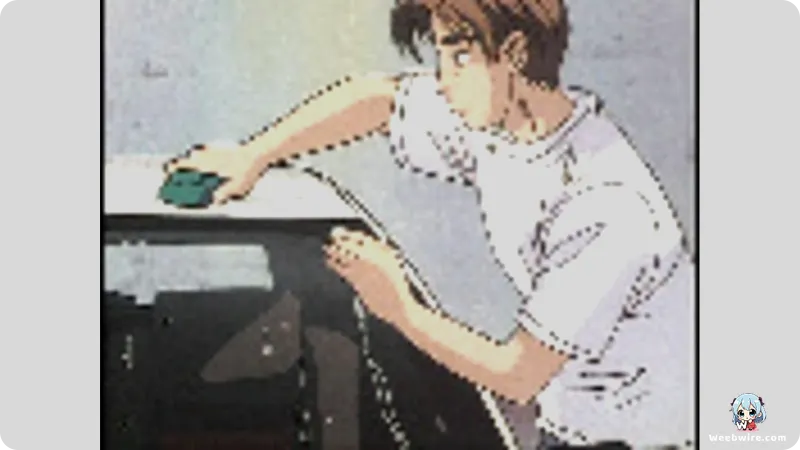More Than Speed: Initial D 1st Stage's Unseen Stories and Lasting Cultural Impact

In 1998, a cultural phenomenon roared onto the anime scene, forever changing the landscape of automotive entertainment. Initial D 1st Stage transcended mere racing, igniting a global passion for street racing and the art of drift that resonates powerfully to this day. Beyond protagonist Takumi Fujiwara's unassuming Toyota AE86 Sprinter Trueno and his legendary tofu delivery runs, the series is a treasure trove of captivating, often overlooked details and groundbreaking production choices that cemented its status as an industry pioneer. Exploring these hidden facets reveals the profound impact and meticulous craftsmanship behind this iconic animation.
Takumi Fujiwara: The Accidental Virtuoso
Central to Initial D's allure is Takumi Fujiwara, an accidental virtuoso unlike any other in anime history. While his rivals meticulously hone their vehicles and skills, Takumi's unparalleled driving prowess emerged from years of mundane, mandatory tofu deliveries across the treacherous slopes of Mount Akina. His initial detachment from the world of competitive racing starkly contrasts with the fervent dedication of his opponents, making his raw, intuitive talent all the more astonishing. Techniques like the audacious 'blind attack' and the infamous 'gutter run' where two wheels drop into the drainage ditch for tighter cornering weren't learned in a classroom. Instead, they were ingenious, practical adaptations born from the necessity of preventing spilled tofu. This seemingly mundane chore inadvertently sharpened his spatial awareness, vehicle control, and intimate understanding of the mountain roads, transforming him into an unwitting legend of the touge. His unconventional approach frequently catches even the most seasoned racers off guard, a testament to his unique, self-taught genius.
The Legendary Hachi-Roku
The 'Hachi-Roku,' as the Toyota AE86 Sprinter Trueno is affectionately known, achieved near-mythical status thanks to Initial D. Before the anime, it was a humble, affordable rear-wheel-drive car, popular but not globally recognized. The series single-handedly propelled the AE86 into an automotive icon. Its compelling narrative as an underdog a seemingly outdated machine consistently outperforming more powerful, technologically advanced rivals struck a chord with audiences worldwide. The show masterfully underscored the supremacy of driver skill over sheer horsepower, a refreshing departure from car-centric narratives. This surge in popularity led to a significant increase in demand and value for the vintage vehicle, as enthusiasts clamored to replicate Takumi's iconic ride. Moreover, the anime's detailed depiction of automotive mechanics, intricate drifting techniques, and the distinct characteristics of each car provided an unexpected, comprehensive education for countless viewers, deepening their appreciation for car culture.

Pioneering CGI Integration
From a technical perspective, Initial D 1st Stage was a true innovator in its integration of computer-generated imagery (CGI) for its dynamic racing sequences. While now commonplace, the seamless blending of 3D car models with traditional 2D hand-drawn backgrounds was revolutionary for television anime in the late 1990s. This hybrid animation method enabled breathtaking camera angles and remarkably realistic vehicle movements that would have been prohibitively complex and time-intensive with conventional cel animation. Though early CGI sometimes exhibited a distinct, slightly blocky aesthetic compared to the fluid 2D character animation creating a unique visual juxtaposition it effectively conveyed the exhilarating speed and intensity of the races. This bold artistic choice by OB Planning established a crucial precedent for future anime productions to explore digital animation more expansively.
The Electrifying Eurobeat Soundtrack
Perhaps no element is more indelibly linked with Initial D than its electrifying Eurobeat soundtrack. The high-octane, propulsive electronic music served as the perfect aural backdrop for the thrilling downhill showdowns, amplifying the adrenaline and excitement of every race. Tracks such as 'Deja Vu,' 'Gas Gas Gas,' and 'Running in the 90s' became instantly recognizable anthems, transcending the anime itself to become viral cultural memes. The strategic selection of Eurobeat a genre originating from Italy and flourishing in Japan's vibrant dance club scene was a stroke of genius, perfectly encapsulating the raw, underground intensity of illegal street racing. The music wasn't merely incidental; it was an indispensable narrative component, intensifying pivotal moments and defining the series' distinctive auditory identity. Many fans credit Initial D with introducing them to the Eurobeat genre, forging an enduring, symbiotic relationship between the animation and its iconic musical score.
Commitment to Realism
The commitment to realism in Initial D extends far beyond the meticulously rendered vehicles and driving techniques to its authentic settings. The fictional Mount Akina is famously inspired by the real-world Mount Haruna in Japan's Gunma Prefecture. Author Shuichi Shigeno dedicated himself to meticulous research, drawing inspiration from actual touge (mountain pass) roads and Japan's thriving street racing subculture. This unwavering dedication to authenticity imbues the races with a gritty, believable atmosphere, transforming them from fantastical duels into high-stakes, palpable confrontations. Shigeno, a noted car enthusiast with personal experience navigating mountain passes, undoubtedly infused the intricate details of the racing sequences and the technical discussions among characters with profound insight. This deep immersion in automotive culture permeated every facet of the series, from the precise sound effects of tires gripping the asphalt to the subtle nuances of vehicle handling.
An Enduring Legacy
Initial D's profound and enduring legacy is vividly reflected in its global impact on car culture. It not only popularized drifting as a legitimate motorsport and an expressive art form but also inspired countless enthusiasts worldwide to embrace the sport. Car meets and drift events globally frequently feature AE86s proudly displaying 'Fujiwara Tofu Shop' decals, a testament to the anime's pervasive and lasting influence. The series also served as a gateway, introducing a new generation to classic Japanese sports cars and cultivating a deep appreciation for their engineering prowess and performance capabilities. Even the voice acting played a crucial role in establishing the series' iconic status; Miki Shinichiro's masterful portrayal of Takumi Fujiwara, delivering lines with a serene, almost detached demeanor that belied his astonishing skill, became instantly recognizable and added profound layers to the character's understated genius.
In essence, Initial D 1st Stage is an extraordinary cultural phenomenon, far exceeding the boundaries of a simple car anime. It stands as a testament to groundbreaking animation, an unforgettable soundtrack, and a protagonist whose singular journey redefined the very essence of a racing legend. From Takumi's unexpected mastery of the touge and the AE86's meteoric rise to fame, to the revolutionary application of CGI, the series continues to enthrall audiences with its exhilarating action and surprising depth. Its indelible legacy is etched not only into the annals of anime history but also deeply within the global automotive community, emphatically proving that true brilliance can emerge from the most unexpected corners.
Credits
Initial D 1st Stage
Author
Shuichi Shigeno
Cover Art
Shuichi Shigeno
Studio
OB Planning
Publisher
Kodansha
Producers





